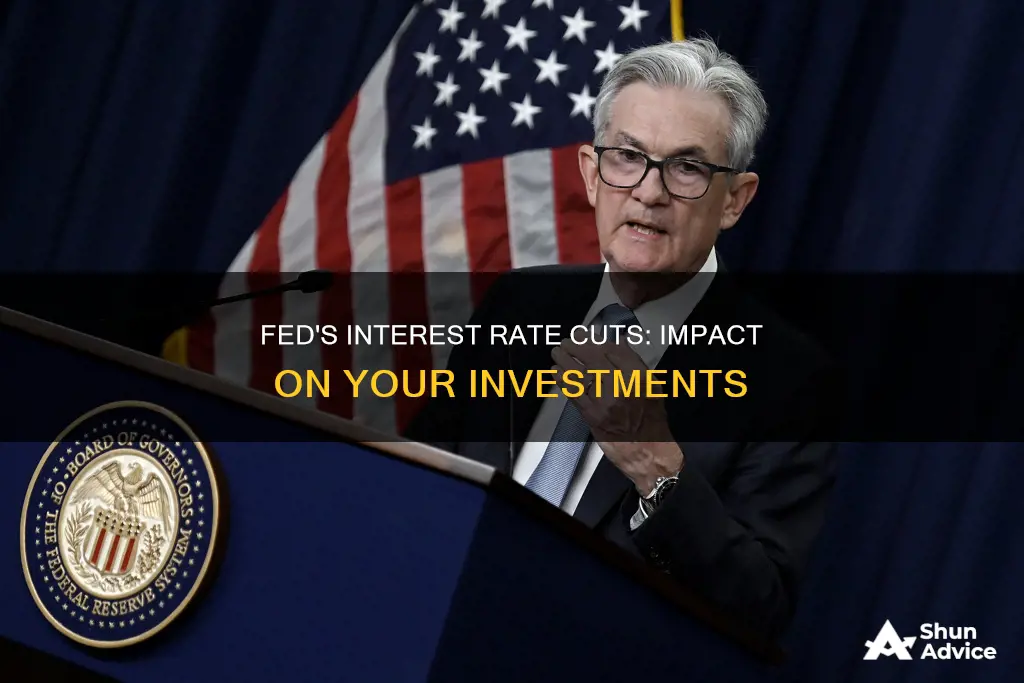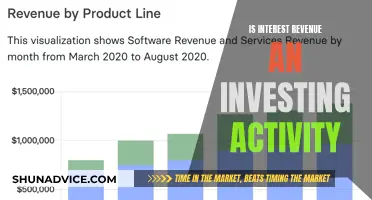
The Federal Reserve (Fed) lowers interest rates to stimulate economic growth and keep the US economy healthy. Lower interest rates are designed to make it cheaper to borrow money and encourage investment and spending. This can have a direct impact on investment portfolios, including 401(k) plans and brokerage accounts. Lower interest rates can also affect the bond market, making them less attractive to new investors.
| Characteristics | Values |
|---|---|
| Impact on stocks | Lower rates are often a boost to stocks, except perhaps financial sector stocks |
| Impact on bonds | Lower rates are a drag on bond prices, making them less attractive to new investors |
| Impact on investors with margin accounts | Lower rates allow investors with margin accounts to take greater advantage of leverage, increasing their effective purchasing power |
| Impact on borrowing | Lower rates encourage borrowing and investing |
| Impact on inflation | Lower rates can spur excessive growth and inflation |
What You'll Learn

How does the Fed lowering interest rates affect stocks?
Lowering interest rates can have a positive impact on stocks. When the Fed lowers interest rates, it makes borrowing money cheaper. This encourages consumers and businesses to spend more, which can create a ripple effect throughout the economy. Businesses are likely to make larger investments in plant, property and equipment, and investors may funnel more capital into the stock market. This can push stock prices higher.
However, lower interest rates can also negatively affect the stock market when they are prompted by an economic slowdown. Lowering rates might also lead to problems like inflation and liquidity traps, which cause a different set of problems.
Interest Rates: Rising Investment Opportunities and Challenges
You may want to see also

How does the Fed lowering interest rates affect bonds?
Lower interest rates from the Fed can push long-term bond prices higher. This is because older bonds with higher interest rates become more valuable, so investors who already own bonds can sell them for a higher price on the secondary market.
However, this is not guaranteed. Bond prices move in inverse fashion to interest rates, so if bond yields decline, the value of bonds already on the market will move higher. But if interest rates rise, bond prices tend to fall. This is because new bonds are issued with higher interest payments, making them more attractive than existing bonds with lower payouts.
Each investor’s individual goals, timeline and risk tolerance will differ, so investing in bonds will look different for everyone. Investors should keep in mind their individual strategy and aim to be as diverse as possible when it comes to asset allocation to offset any potential losses.
Maximizing Returns: Strategies for High-Interest Investments
You may want to see also

How does the Fed lowering interest rates affect borrowing?
The Fed lowers interest rates to stimulate economic growth and encourage borrowing and investing. Lower interest rates make it cheaper to borrow money, which means that people and companies are more willing to borrow and spend. This can spur excessive growth and inflation, which eats away at purchasing power. However, lower interest rates can also increase investors' purchasing power, as they can take greater advantage of leverage at lower rates.
How Interest Rates Affect Investment Decisions
You may want to see also

How does the Fed lowering interest rates affect spending?
Lowering interest rates can have a direct impact on investment portfolios, including 401 (k) plans and brokerage accounts. Lower rates are often a boost to stocks, except perhaps for financial sector stocks, but they can be a drag on bond prices. Lower rates also let investors with margin accounts take greater advantage of leverage at lower rates, increasing their effective purchasing power.
The Fed lowers interest rates to stimulate economic growth. Lower financing costs can encourage borrowing and investing but rates can spur excessive growth and perhaps inflation when they're too low. Inflation eats away at purchasing power and can potentially undermine the sustainability of the desired economic expansion. The Fed will raise interest rates when there's too much growth. Rate increases are used to slow inflation and return growth to more sustainable levels.
The Federal Reserve (Fed) raises rates when the economy is overheating to prevent too much inflation. The goal of cutting rates is to cut the cost of borrowing so that people and companies are more willing to invest and spend. Interest rate changes spill over to mortgage rates, home sales, consumer credit, consumption, and the stock market.
Compounding Interest: Annual vs. Quarterly, Which is Better?
You may want to see also

How does the Fed lowering interest rates affect the economy?
Lowering interest rates is one of the ways the Federal Reserve (Fed) keeps the US economy healthy. The Fed lowers interest rates to stimulate economic growth by encouraging borrowing and investing. Lower financing costs can spur excessive growth and inflation, which eats away at purchasing power and undermines the sustainability of the desired economic expansion.
Lower interest rates directly impact investment portfolios, including 401(k) plans and brokerage accounts. Lower rates are often a boost to stocks, except perhaps financial sector stocks, but they're a drag on bond prices. Lower rates also let investors with margin accounts take greater advantage of leverage at lower rates, increasing their effective purchasing power.
Lower interest rates also affect the bond market, as yields on everything from US Treasurys to corporate bonds tend to fall, making them less attractive to new investors. However, newly issued debt securities offer lower interest rates to holders, while existing debt that carries higher interest rates may trade at a premium—that is, prices in the secondary market may rise.
The Fed will raise interest rates when there's too much growth to slow inflation and return growth to more sustainable levels.
Compounding Interest: Investment Products to Earn More
You may want to see also
Frequently asked questions
Lower interest rates are often a boost to stocks, except perhaps financial sector stocks, but they're a drag on bond prices. Lower rates also let investors with margin accounts take greater advantage of leverage at lower rates, increasing their effective purchasing power.
The Fed lowers interest rates to stimulate economic growth and keep the economy healthy. Lower financing costs can encourage borrowing and investing, but rates can spur excessive growth and perhaps inflation when they're too low.
Fed rate cuts are designed to lower interest rates throughout the economy and make it cheaper to borrow money. This can encourage people and companies to invest and spend.







